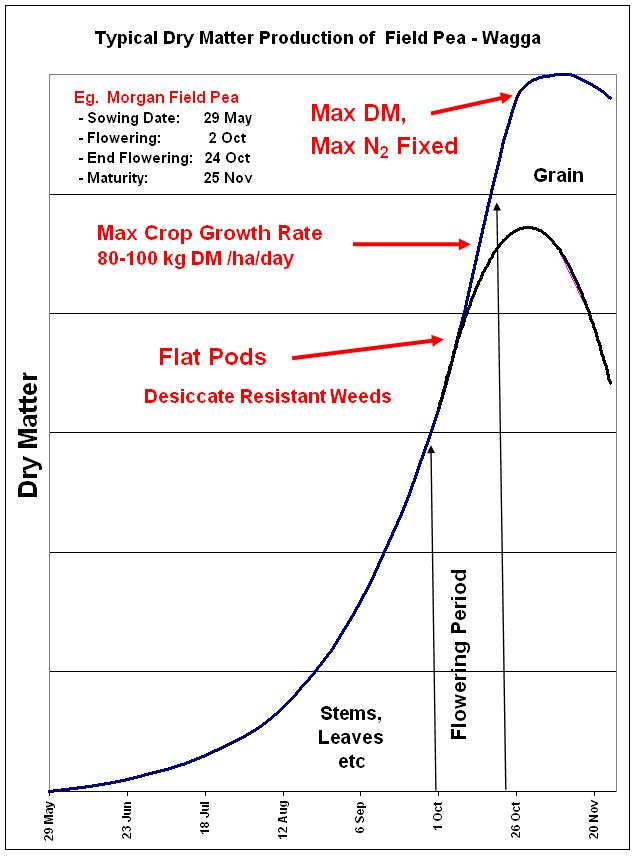The role of pulses and their management in southern NSW
Author: Eric Armstrong, Luke Gaynor, Kurt Lindbeck, Gerard O'Connor, Eric Koetz and Mark Richards | Date: 31 Jul 2013
Take home messages:
- Wheat and canola rotations are running down soil mineral nitrogen levels.
- Pulses can provide a cheaper and more reliable source of N.
- Pulses can be utilised to control weeds, through green manuring, crop topping and good cultural practices.
- Breeding and agronomy improvement are both well supported in Southern NSW by NSW DPI at Wagga and by GRDC.
Introduction
Wheat and canola currently dominate the dryland winter cropping rotation in southern NSW farming systems. This has led to a continual run-down in soil mineral nitrogen associated with an ever increasing dependence on N fertilizer to maintain fertility and production. However, fertilizer N is expensive (linked to fuel prices), its management is risky (particularly with regard to its availability, timing of application and efficiency) and it has long-term environmental implications. Consequently, there is an increasing interest in pulses to provide a cheaper and more reliable source of N, and with brown manuring to maximise this benefit.
Pulses, by definition, are annual legume crops that fix nitrogen from the atmosphere and produce high protein grain for human consumption. The atmosphere is made up of approximately 80% N2 gas, but in this form is unavailable to plants. Legumes (through N2 fixation) and manufacturing (e.g. Urea) offer alternative ways of converting N2 gas into available forms of N for plants.
The role and management of pulses in a southern NSW farming systems therefore largely revolves around the individual needs of the farm, either to supply nitrogen, control weeds, harvest for grain, or a combination of all.
If weeds ARE NOT a problem -
- Grain Harvest - natural maturation. This is the traditional and most wide-spread method of cultivating pulses in NSW and is based on well developed crop management practices from sowing through to harvest. This option assumes weeds can be fully controlled.
- Brown Manuring - to maximise N2 fixation. The amount of N2 fixed is linked closely to dry matter (DM) production of the legume, and therefore, the prime objective here is to “manure” the weed-free pulse at its maximum DM. For a typical MorganA (long-season) field pea crop sown at Wagga in late May (Figure 1), this would mean desiccating around the end of October.
If weeds ARE a problem (herbicide resistance) -
- Brown Manuring - to control herbicide resistant weeds. In this situation, it is essential to desiccate the crop at or before the milky dough stage of the targeted weeds, and this inevitably falls well short of the crop’s peak DM – commonly at the flat pod stage of the legume. Since at this stage, the crop is growing at its maximum rate (around 80-100kgs DM/ha/day), the amount of N fixed will be proportionally reduced according to its growth stage at desiccation (Figure 1).
- Crop Topping - for grain harvest. The “have your cake and eat it” scenario. This option is for weedy situations or where herbicide resistance has become a problem. It uses the conventional approach of grain harvest, PLUS crop-topping at the critical growth stage of the weed. It is largely dependent on the pulse variety reaching physiological maturity at or before the time of crop-topping. Most pulse varieties (eg chickpeas, lupins and KaspaA field peas) are too late, lose too much grain yield and are therefore unsuited. However newer varieties of peas are quicker, and therefore, better suited to crop-topping. An added benefit is that peas are later sown, thus extending weed control windows before sowing. Both PBA OuraA and PBA PercyA flower and mature early.
Considerations
- Brown manuring and crop-topping both use desiccants, the former usually applies to longer-seasoned forage types, the latter on earlier maturing grain types.
- Green and brown manuring incur negative returns during the first year with no grain harvest.
- When grain is harvested, N benefits are reduced proportionally to the N removed in the grain.
- Anything affecting growth (e.g. disease, weeds, drought, sowing time) will directly reduce the N benefit.
- Pulse grain varieties are getting better and better. Pulse Breeding Australia has been very active over the past 10 years breeding new lupin, field pea, chickpea, faba bean and lentil varieties. These crops produce higher and more stable yields, have better disease resistance and are better adapted to southern NSW.
- Agronomy and management of pulses are well documented for southern NSW and the main factors to consider will be outlined in the presentation. Participants are referred to
- “Winter crop variety sowing guide 2013”, NSW Department of Primary Industries
- “Weed control in winter crops 2013”, NSW Department of Primary Industries
- Variety improvement for field pea, lupin, chickpea, faba bean and lentil for southern NSW is undertaken at the Wagga Wagga Agricultural Institute. This work is supported by both NSW Department of Primary Industries and GRDC through its investment in Pulse Breeding Australia (PBA).
- Agronomy and management of pulses for southern NSW is also undertaken at the Wagga Wagga Agricultural Institute (GRDC Project “Expanding the use of pulses in the southern region”). This is a collaborative project between NSW Dept of Primary Industries, Victoria Department of Primary Industry and South Australian Research & Development Corporation (SARDI).

Figure 1. Dry matter production of MorganA field pea over the growing season at Wagga under good growing conditions and free of disease and weeds.
Contact details
Eric Armstrong, Wagga Wagga Agricultural Institute
02 69381814
eric.armstrong@industry.nsw.gov.au
www.dpi.nsw.gov.au
Was this page helpful?
YOUR FEEDBACK
